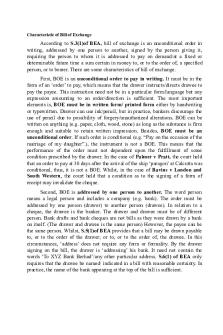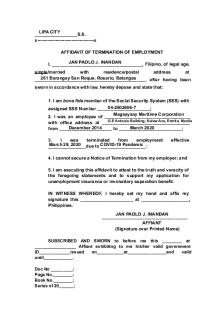Perils of Prosperity PDF

| Title | Perils of Prosperity |
|---|---|
| Author | Alexandra Foto |
| Course | Seminar In American History Since 1900 |
| Institution | Southeastern Louisiana University |
| Pages | 4 |
| File Size | 111.8 KB |
| File Type | |
| Total Downloads | 66 |
| Total Views | 132 |
Summary
Download Perils of Prosperity PDF
Description
Alexandra Foto Perils of Prosperity History 607 9 March 2020 In The Perils of Prosperity, Professor Leuchtenburg portrays the years 1914-1932 as an era of transition, tension, and paradox. It marked an uncomfortable way station between a nation predominantly rural, traditional, and provincial, fundamentalist in its religion, with a premium still on the virtues of craftsmanship, neighborly, equalitarianism, and an America urban, mechanized, secular, and sophisticated. The nation’s reform impulse was shifting from old-style evangelical reformism, not yet dead, to a new style of urban progressivism, not yet fully arrived.1 Leuchtenburg reaches back to 1914 for his start since the perils of war, and the perils of prosperity were at first closely intertwined and continue to 1932. However, by that time, perils had pretty well eaten up the prosperity. His ideas are developed with chapters, in the form of essays, arranged in chronological order. The chapter titled “Innocents Abroad” recounts America’s participation in World War I. “The Red Scare” is checked by hedonism, not liberalism, and Republican foreign policy is considered the only practical solution, even though it was shortsighted. In “Tired Radicals,” Leuchtenburg argues progressivism died because it did not join the newer urban Progressivism of Alfred Smith, but the fundamental differences between the movements are not examined.2 In “The Revolution in Morals,” the weakening of the importance of moral values is indicted justly, even though it did alleviate the harsher judgments of rural Protestantism. A revision of interpretations that find Hoover a do-nothing president or a tool of Wall Street is attempted by citing the Agricultural Marketing Act, the R.F.C., the Grain Stabilization 1 William E. Leuchtenburg. Perils of Prosperity, (Chicago: The Chicago Press, 1993), 138 2 Leuchtenburg, 234
Corporation, and the Federal Home Loan Act. This approach, fair as it is, is difficult to reconcile with the evidence presented, which shows that Hoover refused to believe his experts on the numbers of unemployed and the significance of the problem and that he vetoed relief and public works bill as late as 1932. Many social and cultural changes significantly impacted the nineteen twenties. The second industrial revolution brought about the invention of machines that made everyday life easier and gave birth to mass culture. The production of the automobile gave millions of Americans the freedom to travel easily to new places. Other major technological advances included electricity in homes, especially in industrialized cities, which provided the power to run new labor-saving devices such as refrigerators, washing machines, irons, vacuum cleaners, and the radio, with the first commercial station airing in 1920.3 Furthermore, the disintegration of traditional values was reflected in a revolution in manners and morals that shook American society to its depths.4 Sexual mores, gender roles, hairstyles, and dress all changed profoundly during the nineteen twenties. In particular, the “new women” revolted against the over-evaluation of women as love objects and fought for the same freedom of movement, economic, and political rights as men. The nineteenth amendment legalized women’s suffrage, and by 1930, more than ten million women held jobs and could afford to participate in the consumer economy.5 The newfound freedom for these women spawned a significant change in the workings of the family. The popularization of household inventions made time-consuming tasks less gruesome and allowed women the freedom to pursue other interests.
3 Leuchtenburg, 196 4 Leuchtenburg, 157 5 Leuchtenburg, 159
The nineteen twenties also initiated a cultural civil war, which became a significant source of social tension. The Great Migration of African Americans from the south to northern cities and the increasing visibility of black culture- jazz and blues music, and the Harlem Renaissance- discomfited some white Americans. An anti-Communist Red Scare encouraged a widespread nativist hysteria. It led to the passage of the National Origins Act of 1924, which drastically cut down the total of newcomers each year and established quotas based on the proportion of descendants of each nationality resident in the United States at an earlier time.6 Furthermore, the rejection of tradition and earlier idealism freed writers to experiment with new forms of literature. The nineteen twenties were a decade of profound change. Many Americans regarded these changes as liberation from the country’s Victorian past. In Perils of Prosperity, the nation’s insecurities rose out of the fast-paced historical change. Its contradictions are explained as the reluctance of the American people to come to terms with the new realities of American life: “a strong state, the dominance of the metropolis, secularization and the breakdown of religious sanctions, the loss of authority of the family, industrial consolidation, international power politics, and mass culture.” These conflicts between city-dwellers and small-town residents, immigrants and citizens, “new women” and advocates of old-fashioned family values, and the product of the second industrial revolution are perhaps the most important aspects of the Roaring Twenties.
6 Leuchtenburg, 207...
Similar Free PDFs

Perils of Prosperity
- 4 Pages

The perils of bad strategy
- 10 Pages

Scope OF Sociology OF Health
- 9 Pages

Importance of Chain of Command
- 3 Pages

solution of mechanics of materials
- 1,597 Pages

Table of Muscles of Mastication
- 1 Pages
Popular Institutions
- Tinajero National High School - Annex
- Politeknik Caltex Riau
- Yokohama City University
- SGT University
- University of Al-Qadisiyah
- Divine Word College of Vigan
- Techniek College Rotterdam
- Universidade de Santiago
- Universiti Teknologi MARA Cawangan Johor Kampus Pasir Gudang
- Poltekkes Kemenkes Yogyakarta
- Baguio City National High School
- Colegio san marcos
- preparatoria uno
- Centro de Bachillerato Tecnológico Industrial y de Servicios No. 107
- Dalian Maritime University
- Quang Trung Secondary School
- Colegio Tecnológico en Informática
- Corporación Regional de Educación Superior
- Grupo CEDVA
- Dar Al Uloom University
- Centro de Estudios Preuniversitarios de la Universidad Nacional de Ingeniería
- 上智大学
- Aakash International School, Nuna Majara
- San Felipe Neri Catholic School
- Kang Chiao International School - New Taipei City
- Misamis Occidental National High School
- Institución Educativa Escuela Normal Juan Ladrilleros
- Kolehiyo ng Pantukan
- Batanes State College
- Instituto Continental
- Sekolah Menengah Kejuruan Kesehatan Kaltara (Tarakan)
- Colegio de La Inmaculada Concepcion - Cebu









